The WWWF Championship became the WWF Championship in 1979, for marketing purposes. It would remain as such until May 2002, when the then-WWF was forced to change their name to WWE.
In June 1982, Vince McMahon Jr purchased the Capitol Wrestling Corporation (the parent company of the WWWF) from his father, Vince McMahon Sr. (They're not technically Junior and Senior, as they have different middle names, but calling them that makes things a lot easier).
McMahon Sr, was 68 years old at the time and accepted it was time to step down and hand over the reigns to his ambitious 36 year old son, who incorporated the WWWF into his parent company, Titan Sports. McMahon Sr would sadly pass away just two years later.
McMahon Jr had a very different vision for what WWE could be than that of his father. While McMahon Sr, despite his differences with the NWA, had largely respected regional boundaries, McMahon Jr saw the future of wrestling as cable television and sought to make the WWF the first truly national wrestling promotion.
These WWE segments are not for kids - Watch here 😏
When McMahon Jr took over the company, the clean cut babyface champion, Bob Backlund reigned as champion. The goody two shoes character was a hit at the box office, but was not a suitable figurehead for a national or international organization.
Backlund also lacked charisma and personality, two intangibles that McMahon Jr viewed as essential for his World Champion.
Therefore in late 1983, he made a call to Hulk Hogan.
Hogan was no stranger to the WWF, having worked for the company as a heel in 1979. In-between he had starred in the movie Rocky III. He worked for Verne Gagne's AWA promotion while also touring New Japan Pro Wrestling with Gagne's blessing.
The AWA paid Hogan handsomely for a limited schedule which offered him flexibility when he wished. Therefore McMahon Jr had to make him an offer he couldn't refuse. That offer was the WWE Championship in his first return match for the company.
McMahon Jr not only purchased Hogan, he lured backstage interviewer, Gene Okerlund from the AWA as well, signalling the death knell for that promotion.
Hogan was installed as WWE Champion in January 1984 and the rest as they say is history.
In the second part of my series, part 1 can be found here, I will cover the reigns of Superstar Billy Graham through to Macho Man Randy Savage.
Superstar Billy Graham (April 30, 1977 - February 20, 1978)
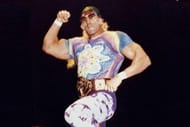
Bruno Sammartino's final reign as WWWF Champion was terminated by Superstar Billy Graham on April 30, 1977 at the Baltimore Civic Center.
It was actually Bob Backlund who had initially been recommended to Vince McMahon Sr as Sammartino's successor by the NWA boss, Sam Muchnick. However, both McMahon Sr and Muchnick felt the four year pro needed further seasoning as a wrestler before being given such a prominent spot.
That's where Graham fit in. Graham was chosen to act as a transitional champion much like Koloff and Stasiak had been earlier in the decade (see part 1 when you're done here), but the transition was to take place over a much longer period to give Backlund time to develop appropriately for the spot.
When McMahon Sr booked Graham to win the strap, he already knew the date he would lose it. In the intervening 296 days, Graham was a revelation as champion.
If he had not been a heel, he may well have been Sammartino's long term successor. Graham was the full package; he possessed boatloads of charisma, with his Mohammad Ali inspired rhyming promos, incredible physique and eye catching tie dye ring gear, making him a box office success.
Graham contested energetic and high drawing rematches with Sammartino, retaining the strap each and every time. Graham also defended the belt versus future NWA World Champion Dusty Rhodes, Mil Mascaras, High Chief Peter Maivia (grandfather of Dwayne "The Rock" Johnson) and others. Business was booming throughout Graham's reign, but time was almost up. Backlund's coronation was due.
Graham attempted unsuccessfully to persuade McMahon Sr to delay Backlund's title win, but McMahon Sr was unmoved. Backlund would win the WWWF Championship as planned on February 20, 1978. Graham's solitary WWE Championship run was over.
Bob Backlund (February 20, 1978 - December 26, 1983)
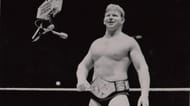
Bob Backlund didn't really look like the typical World Champion. An accomplished amateur wrestler, Backlund definitely had the credentials. But his clean cut demeanor and average physique meant he did not appear to be a match for many of the top stars of the era.
However, this was precisely the attraction of Backlund as champion. An underdog face champion was a novel concept at the time and one that proved to be dynamite at the box office, as Vince McMahon Sr's midas touch continued.
Backlund cleanly pinned Superstar Billy Graham to become champion on February 20, 1978. He defended the strap successfully versus a wide array of notable opponents such as former champions, Stan Stasiak and Ivan Koloff, plus Ken Patera, High Chief Peter Maivia and as his reign entered the 1980s, fresh opponents such as Sgt Slaughter, Killer Khan and Antonio Inoki to name a few.
However, when McMahon Sr's son, Vince Jr. purchased the newly re-monikered WWF in 1982, Backlund was not the figurehead required for his national expansion. Cue his title loss to the Iron Sheik in December 1983.
The Iron Sheik (December 26, 1983 - January 23, 1984)
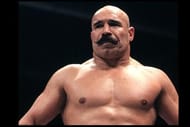
Like Ivan Koloff and Stan Stasiak before him, The Iron Sheik was the very definition of a transitional champion.
The title change was a colossal upset when it occurred in December 1983, bringing to a close Bob Backlund's near six year title run as titleholder.
There was a degree of controversy in the outcome. As Sheik held Backlund in the Camel Clutch, Backlund's manager at the time, Arnold Skaaland, threw in the towel on Backlund's behalf, gifting the title to Sheik.
Backlund was incensed at Skaaland, as he stated that he had no intention of submitting to Sheik. The finish protected Backlund, but the outgoing champion would never receive a rematch.
The transition had begun. Backlund and the pre-cable television era were out and Hulkamania and the MTV generation were in.
Hulk Hogan (January 23, 1984 - February 5, 1988)
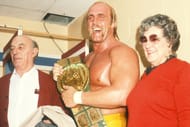
Vince McMahon Jr's national expansion began with Hulk Hogan at the fore in January 1984.
Hogan, a star with mainstream recognition following his appearance in the mega-hit movie Rocky III in 1982, was a brand new acquisition by McMahon.
Hogan was slated to be the star to make wrestling mainstream. The Hogan/McMahon relationship was a match made in wrestling heaven.
With McMahon's aggressive expansion plans and booking prowess matched with Hogan's electrifying charisma and box office appeal, the pair turned WWE into the most famous wrestling promotion in the world.
Wrestlemania in March 1985, headlined by Hogan and A-Team star Mr T in a match against Rowdy Roddy Piper and "Mr Wonderful" Paul Orndorff. The event was a celebrity bonanza, and cemented WWE into the consciousness of non-fans.
Wrestlemania III in March 1987 attracted 78,000 fans to the Pontiac Silverdome to see Hogan defend the title versus Andre the Giant. That attraction attracted a colossal 400,000 orders on the fledgling medium of pay per view; a staggering number of orders considering only a few million homes were wired for pay per view in 1987.
So successful were Hogan headlined events that every wrestler in the company wanted to be booked on the same card as him as their payoff would be significantly higher, just by competing on the same live events.
Hogan was the golden goose that kept on giving and his first title run was his most successful. The power of Hulkamania enabled WWE to add a second annual super-card to it's books in 1987, the Survivor Series.
That event, again booked on the back of the Hogan/Andre feud attracted a massive 325,000 buys.
No doubt, Hogan was The Man.
Andre The Giant (February 5, 1988 - February 13, 1988)
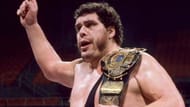
Andre the Giant was one of the three highest earners and biggest names in wrestling during the 1970s and early 1980s.
However, by the time he "won" the WWE Championship in February 1988, he was long past his prime.
Andre was barely mobile at this point but he was still an attraction and a box office draw. The Hulk Hogan/Andre WWE Championship rematch screened on NBC's prime time special, The Main Event, and pulled in an astonishing 33 million viewers. That was the largest audience ever to watch a wrestling match. It still is.
A lackluster bout had a truly bonkers ending. Andre had pinned Hogan to the mat. Despite Hogan raising his shoulder from the mat on the count of one; the referee continued to count to three.
You see, the scheduled referee for the bout was Dave Hebner, but his evil twin, Earl, had secretly switched places with him and was the one to count the pin. Dave Hebner later stormed the ring and engaged in a war of words with his twin brother.
Hogan was incensed, as was the crowd. The craziness didn't stop there. Andre then cut a promo in which he immediately relinquished the WWE Championship to Ted DiBiase, who had purchased the belt.
Andre's only WWE Championship reign lasted mere minutes. However, despite it's brevity it is still well remembered three decades on.
Macho Man Randy Savage (March 27, 1988 - April 2 1989)
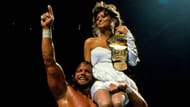
Following the Hulk Hogan/Andre the Giant/Ted DiBiase title debacle, WWE President, Jack Tunney stripped DiBiase of the WWE Championship and struck his reign from the record and vacated the strap. Which is why he doesn't have an entry here.
The vacated WWE Championship was put up for grabs in a one night tournament at Wrestlemania IV on March 27,1988. Pre-tournament favorites Hogan and Andre were pitted against each other in the Quarter Finals, where they also eliminated each other via Double Disqualification.
That cleared a path for former Intercontinental Champion, Macho Man Randy Savage, to take the gold.
Savage was a major star and had gotten over huge as a babyface in the run up to the super-card.
Savage bested Butch Reed, Greg Valentine, One Man Gang and lastly Ted DiBiase to claim the title.
A superlative worker, Savage was the most talented wrestler to hold the title at that point. He had sterling defenses versus the likes of DiBiase, Haku, One Man Gang and Big Boss Man.
He was a smash at the box office too. However, despite his success, his title reign was never going to last longer than one year. His friendship and tag team with Hogan was about to implode in spectacular fashion and set up the richest main event in wrestling history.
There's plenty more to come! Who was your favorite WWE Champion of the 1970s and 80s? Give us your picks in the comments section below!
Big issue with Rhea Ripley revealed HERE

